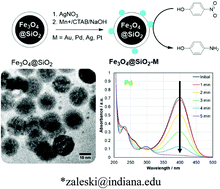A simple route to diverse noble metal-decorated iron oxide nanoparticles for catalysis†
Abstract
Developing facile synthetic routes to multifunctional nanoparticles combining the magnetic properties of iron oxides with the optical and catalytic utility of noble metal particles remains an important goal in realizing the potential of hybrid nanomaterials. To this end, we have developed a single route to noble metal-decorated magnetic nanoparticles (Fe3O4@SiO2–M; M = Au, Pd, Ag, and PtAg) and characterized them by HRTEM and STEM/EDX imaging to reveal their nanometer size (16 nm Fe3O4 and 1–5 nm M seeds) and uniformity. This represents one of the few examples of genuine multifunctional particles on the nanoscale. We show that these hybrid structures have excellent catalytic activity for the reduction of 4-nitrophenol (knorm = 2 × 107 s−1 mol(Pd)−1; 5 × 106 s−1 mol(Au)−1; 5 × 105 s−1 mol(PtAg)−1; 7 × 105 s−1 mol(Ag)−1). These rates are the highest reported for nano-sized comparables, and are competitive with mesoparticles of similar composition. Due to their magnetic response, the particles are also suitable for magnetic recovery and maintain >99% conversion for at least four cycles. Using this synthetic route, Fe3O4@SiO2–M particles show great promise for further development as a precursor to complicated anisotropic materials or for applications ranging from nanocatalysis to biomedical sensing.


 Please wait while we load your content...
Please wait while we load your content...